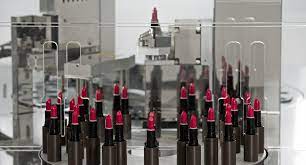
This new application receives its public presentation at the start of what experts define as “the year of Artificial Intelligence”, in which the spread of technologies based on deep learning and neural networks is expected to make a big leap forward in quality terms. Accompanying this development, the portfolio of algorithms that underlie the SEA Vision Group software packages will continue to evolve towards new horizons in AI. Today, therefore, we witness the presentation of a still-evolving solution for use in a very dynamic context of great interest, which embraces all aspects of our daily lives.
Lipsticks: a wonderful product but complex to manufacture and control
After the successful launch – at Achema 2022 – of its solution for automating pharmaceutical Line Clearance processes with the aid of neural algorithms, SEA Vision Group offers the first glimpse of a new AI-based lipstick inspection system. Through the automation of processes still subject to human control, this solution aims to improve the packaging of a product currently considered one of the world’s bestselling cosmetics.
The essential ally of all (or almost all) women, lipsticks come in countless colours, finishes, shapes, formulations and combinations, and many of them, especially in the luxury sector, feature logos and sophisticated decorations impressed on the body or tip of the product.
These distinctive styling features – together with the complexity of the industrial process required to perfectly amalgamate the pigments, oils, waxes and emollients in its formula – mean that lipstick is complicated to produce and verify in terms of product quality. Even today, in spite of all the efforts made during production to prevent and control a whole series of potential defects, some flaws still pass through quality control undetected. This leads to costly reprocessing: in the worst-case scenario, these products make it onto the market, implying serious risks for businesses in terms of brand reputation.
FOCUS: some examples of defects
Some of the most common defects on the body of the lipstick are:
- product defects and deformation: stick diameter and height, shape, and tip geometry;
- burrs and drips;
- appearance flaws: surface micro-holes, scratches, chipping, foreign bodies, defects in embossing such as logos or textures engraved or in relief on the body of the lipstick;
- uneven colour: streaks, variations in colour.
The frontier of Artificial Intelligence
Artificial Intelligence sets out to remedy a large proportion of these potential defects. The SEA Vision Group system (under development by a joint team from SEA Vision Group and ARGO Vision) uses the semantic segmentation of the areas of the lipstick (e.g. body, tip, neck, mechanism, etc.) to identify every possible flaw pixel by pixel. This is achieved by classifying areas into categories, each of which is assigned a name or “label”. Each part or area of the image is classified by categories and identified by a colour on the screen to provide the operator with immediate information about the areas being inspected.
The system learns how to discern an ever-increasing variety of more and more complex defects, item by item. Learning takes place both on the basis of proprietary datasets – a mix of real and synthetic images generated with the most advanced data augmentation and neural generation techniques – and by combining the different models and parameters observed over time.
These deep learning-based semantic segmentation techniques, now the de facto standard in the Artificial Intelligence field, greatly accelerate the development of capabilities for the analysis of objects. In other words, the ever-expanding range of scenarios the system can consider enables the system itself to evolve and become more and more precise.
The learning process that defines the quality control algorithms continually evolves, to release increasingly sophisticated new versions. In this specific issue, the final goal is to generalise the “concept” of lipstick, making the algorithms more and more specialised in quality control regardless of the product’s possible shape, colour and texture (e.g.: satin, transparent, matt, pearl, glitter, etc.).
“The main feature of this innovation, differentiating it from conventional vision systems which can detect defects in images through comparison with models already known at the outset,” explains Alessandro Ferrari, CEO of ARGO Vision, “is the system’s ability to learn from past examples and thus constantly increase its analysis capability, which is more or less what we humans do when we learn from experience.”
All in all, pre-neural technologies proved incapable of identifying, with precision, a whole series of defects and flaws which may arise during lipstick quality control. Today, thanks to AI, it is possible to deliver an even higher quality final product, by preventing imperfections that may affect a user’s perception of a specific brand.






